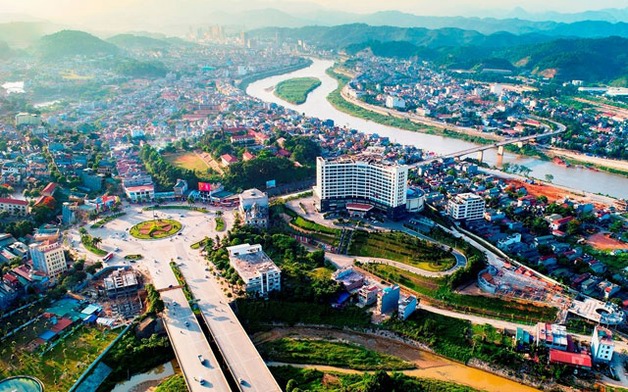Lao Cai

Lao Cai Province of Vietnam is located in the north-western region of the
country. Lao Cai shares border with China to the north, with
Ha Giang to the
east, with Yen Bai to the southeast and south, and with
Lai Chau to the
west. The capital of the province is Lao Cai City, 300km north-west of
Hanoi. The province possesses sublime untouched natural beauties, rich and
colorful ethnic cultures, and has long been a popular tourist attraction for
the Vietnamese tourists as well as for foreign visitors.
Lao Cai has mountainous terrains with the mountain ranges of Hoang Lien to
the west and Con Voi (Elephant) to the east. Most of the terrains of Lao Cai
are from 300m to above 1,000m above sea level. The two highest mountain
peaks in the province are
Fansipan (3,143m) and Ta Giang Phing (3,090m).
Both mountain peaks offer challenging trekking and hiking adventures.
There are two main river systems in Lao Cai Province: the Red River and the
Chay River which have river basins with fertile alluvial soil. The Red River
flows into Vietnam from China at A Mu Sung (Bat Xat District, Lao Cai) going
south-east right along the borderline between
Vietnam and China all the way
from Bat Xat to Lao Cai City. The Red River keeps the general direction from
north-west to south-east all the way from Lao Cai, through Yen Bai, Phu Tho,
Hanoi and other provinces in the Red River Delta before discharging its
water into the East Vietnam Sea.
The Chay River starts from western side of Ha Giang at Kieu Lieu Thi
Mountain flowing through Si Ma Cai and
Bac Ha Districts of Lao Cai, then
flow through Yen Bai into
Thac Ba Lake, then discharging its water into the
Lo River at Doan Hung (Phu Tho Province). There are various ethnic
communities living along the rivers in Lao Cai. Cruising along the Chay
River in Bac Ha District to visit different ethnic villages is a great
experience.
Lao Cai has a tropical monsoon climate with two main seasons: the rainy
season is from April to October and the dry season from November through
March. Because different areas of Lao Cai are separated by high mountain
ranges and with very different altitudes, the climate may vary dramatically
from one place to another. It may be good to know that the winter in Lao Cai
could be extremely cold below freezing point and expect snow some time in
late December, January, early February. It is normal for Lao Cai to have
snow in the high mountains in the winter.
Lao Cai has the average rainfall of 1,800mm to over 2,000mm per annum.
During the rainy season, some areas of Lao Cai may suffer from landslides
and flash floods. If you plan a motorbike tour or a trekking trip in Lao Cai
during the rainy time, it is advisable to consult local travel agencies and
tour operators for the most up-to-date information.
Lao Cai Province is inhabited by 25 groups of peoples including the Kinh
(36%), Hmong (22%), Tay (16%), Dao (14%), Giay (5%), Nung (4%),.... Most
ethnic minorities keep their traditional culture unchanged as it has been
for centuries: they are dressed in the same daily traditional costumes, have
the same housing style, working on the same rice terraces... Traveling
through different areas of Lao Cai, you will encounter different ethnic
minorities where ever you go.
Tourist attractions and what to see in Lao Cai
While Lao Cai is a popular travel destination, tourism in the province has
been mostly limited to Sapa and the surrounding villages only. There are
vast regions around Bac Ha, Si Ma Cai, Muong Khuong, Bat Xat that are not
much visited by travellers.
There are colorful ethnic markets in Bac Ha and Muong Khuong on Sunday
morning and at Can Cau (in Si Ma Cai) on Saturday morning.
Besides, there are amazing rice terraces in
Sapa, Bat Xat and Muong Khuong.
These terraces are great for photography in late May-early June when they
are flooded ready for rice-transplanting, and in late September-early
October when the rice turns into golden colors.
Y Ty in Bat Xat is located on an altitude of 2,000m above sea level with
cool climate all year round. Y Ty has potential to turn into a mountain
resort soon





